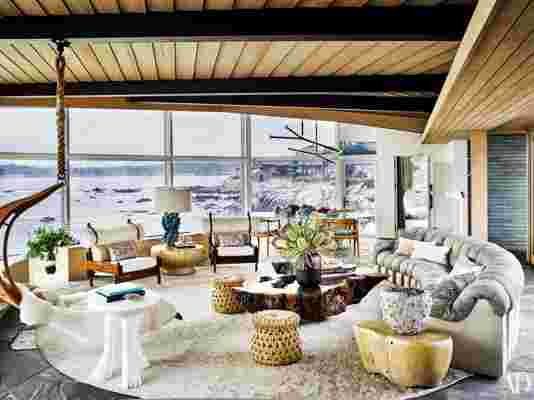The first time Londoner Hannah Comolli (then Hannah Broke-Smith) visited Northern California, she fell in love with the rugged beauty of the coastline. A few years later, still living in London, she would fall in love again, this time with Kevin Comolli, an American businessman based in the British capital. They quickly discovered a shared passion for the Golden State, and as luck would have it, Kevin’s technology–venture capital firm had a Palo Alto office he visited often. “Each time we would add a few extra days to explore the area,” Hannah recalls. “Increasingly we found it hard to leave.”
Eventually the Comollis decamped from London for a new life in Carmel, hard by the Pacific. “We wanted to raise our children outside the noise of big-city life in an area that feels both invigorating and nurturing,” Hannah explains, adding, “There is something about the particularly golden light and blue sky and the smell of the ocean and cypress trees that just fills my soul. Although I was born and raised in England with English parents, California—and in particular Carmel—feels like my true spiritual home.”
The couple had long admired architect Frank Wynkoop’s 1951 Butterfly House, so named for the structure’s signature winged roof design. Perched atop a rocky coastal outcropping, the residence was one of only a handful of oceanfront properties in the area. “I never imagined it could be a family home,” Hannah says of its relatively compact footprint of approximately 3,000 square feet. “But the moment we walked into the house I felt overcome with excitement. We knew immediately it was a treasure,” she says. “It feels like you’re living in the most fabulous aquarium, in harmony with the ever-changing seascape and the extraordinary array of marine life just beyond the doorstep.”

In the living room, a rattan lounge by Blackman Cruz hangs opposite a De Sede sofa. Three-legged side table by John Dickinson; vintage Sergio Rodrigues chairs with Mongolian lamb bolsters; Imbuia wood cocktail table by Pedro Petry; rug by Tufenkian.
Determined to respect Wynkoop’s original vision, the Comollis set about finding a designer attuned to the idiosyncratic architecture and spectacular setting. “We interviewed a lot of candidates, but when we met Jamie we were blown away,” Hannah says, describing the couple’s first meeting with Los Angeles–based designer Jamie Bush.
“It’s a magical house in a magical spot,” Bush says of the landmark architectural gem. “When you’re in the living room, you feel like you’re standing on the prow of a ship, with fog rolling in, seals swimming by, whales breaching, and pelicans alighting on the rocks. It’s mesmerizing.” Bush says his design concept was based on bringing the rugged, organic, even brutal quality of the shoreline into the look and feel of the interiors. “The essence of midcentury design is about effortless indoor-outdoor living,” he explains. “I wanted the interiors to celebrate the irregularities of pattern and texture in nature. Hannah and Kevin really understood the power of that idea.”


Bush likens the restoration to an archaeological dig, with myriad discoveries both good and bad. Along with complex structural issues, the designer uncovered the home’s original steel beams, which had been hidden under drywall. Rather than entombing them again, Bush left the steel members exposed, treating them with a new waxed finish. He also deployed materials that could move seamlessly from indoors to out, including wire-brushed teak and hand-molded bricks chosen both for their aesthetic qualities and for their ability to withstand the coastal climate. Oversize quartzite flagstones were meticulously pieced together to create floors that flow from the interiors through the pool courtyard and onto the driveway.
Since the family was downsizing from a much larger home in London, clever planning was essential. “It was like designing a boat—every space had to be considered and used to its maximum potential,” says Kevin. Bush seconds the notion: “We designed an incredible amount of built-ins, hidden drawers, cabinets, and bookcases, every piece elaborately detailed. That kind of craftsmanship takes a lot of time, precision, and, most important, patience.”
I wanted the interiors to celebrate the irregularities of pattern and texture in nature.
The interiors are outfitted with hand-troweled plaster walls, carved-stone sinks, custom bronze hardware, and hemp-and-silk rugs, all joined by pedigreed vintage furnishings as well as site-specific commissions from contemporary artisans such as renowned California ceramist Stan Bitters. “Jamie’s great success was marrying midcentury with a contemporary sensibility and the practicality of a family home,” says Hannah. “He also managed to indulge our passion for luxurious furnishings.”
“I really love that the house is so compact and very transparent. Sitting at my desk I can see the kids playing in the garden—it creates an intimate family experience,” Kevin notes. Hannah adds, “Our son’s favorite spot is the hanging chair in the great room. The pool is in use almost daily, and the addition of the hot tub is especially appreciated after surfing in the chilly Pacific.”
Ultimately the Comollis look back on their transatlantic and transcontinental shift with deep satisfaction. “This house is so hugely different from the homes we created in London and the English countryside. The project had many challenges and bumps along the way, but the end result speaks to a complete and unwavering commitment to quality and preservation,” says Hannah. “We feel very fortunate to live here. To us the Butterfly House is a treasure. We feel honored to call it home.”
